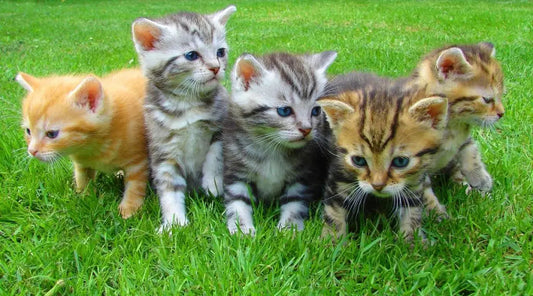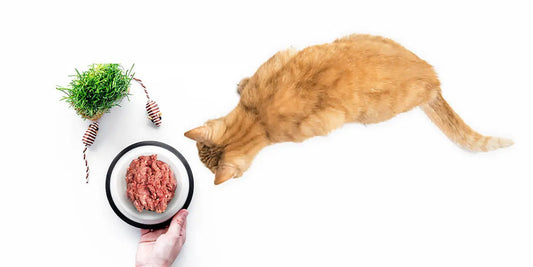
Top Benefits of Wet Food for Cats
Spacious catios, organic catnip, premium cardboard boxes: You do a lot to give your cat the best care possible.
Though playtime and affection are important to your cat’s health, one of the most essential aspects of cat care is managing their diet. Cats need lots of nutrients to thrive (and cause their usual mischief), which they must obtain from food. To keep your feline feeling healthy and loved, it’s important to fill their food bowl with well-balanced, nutrient-rich meals.
And conscious cat owners agree: Wet cat food is best.
Let’s end the wet vs. dry cat food debate once and for all: Learn the many benefits of wet food for cats and why it’s the best choice for a happier, healthier feline.
Wet Food vs. Dry Food
Choosing between wet vs. dry food for cats can feel like a challenge, but understanding the clear differences can simplify the decision. Wet food typically offers more water content, better hydration, and higher protein levels, which support a cat’s natural carnivorous instincts. Dry food, on the other hand, is more calorie-dense, which can be a benefit for cats needing to gain weight, but it often leads to dehydration and can exacerbate certain health conditions.
4 Ways Wet Food Supports Feline Health
Wet food offers several key health advantages to cats, especially those living with pre-existing conditions such as obesity and kidney disease. Here are just four of the myriad reasons why wet food is the best meal option for your cat.
#1: It Promotes Hydration
Some cat owners choose dry cat food because it stores longer and generally costs less, but it often lacks some of the key nutrients your cat needs to thrive—the first and most important one being water.
Have you ever noticed that your cat doesn’t drink much from their water bowl? That’s because their ancestors gained most of their hydration from eating prey, reducing their natural inclination to drink water. Similarly, your cat’s food must account for these natural behaviors. How do cats communicate with each other? By scent and cat body language, which also influences their instincts regarding hydration and eating behaviors.
Let’s compare the water content of wet vs. dry cat food:
-
Dry food – 6-10% water
-
Wet food – 75% water
These numbers show that wet food helps meet feline hydration needs far better than dry food. To further support your cat's hydration, discover practical tips in our article on how to keep your cat hydrated.
#2: It Supports Urinary Tract and Kidney Health
Your cat needs to be properly hydrated to function at their best. In fact, proper hydration supports their most essential functions—including those of their urinary tract.
Everyone needs to pee, right? Cats, however, have more highly concentrated urine than other animals, which can cause urinary crystals or stones to form and lead to concerning urinary tract diseases. With its high water content, wet food helps dilute felines’ urine and promotes a healthier urinary tract.
Cats with these other common conditions benefit significantly from proper hydration and dilute urine:
-
Feline interstitial cystitis
-
Chronic urinary tract infections
-
Chronic kidney disease
It’s clear: Moisture-rich wet food is the number one choice to help your feline go number one.
#3: It Aids Nutrient Absorption and Digestive Health
Another common cat quirk is that they tend to be a bit puke-prone. Feeding your cat a nutrient-rich diet that supports healthy digestion benefits all cats with unsettled stomachs, but especially those with:
-
Infectious diarrhea
-
Inflammatory bowel disease
-
Gastrointestinal lymphoma
-
Chemotherapy treatments
Again, wet food wins out for cats. In addition to having a higher water content, wet food contains greater amounts of protein than dry food. (Dry food is more carb-heavy to help with the baking process.)
Cats are obligate carnivores, meaning they need meat in their diet to survive. Their bodies have specially evolved to digest high-protein diets, including the development of a shorter digestive tract to speed up nutrient absorption.
Wet foods containing meat or animal-based proteins more closely mimic the diet of your cat’s ancestors, making them more nutritious—and easier on the tummy.
#4: It Helps Manage Weight and Prevent Obesity
Let’s compare another important aspect of wet vs. dry cat food: calorie count:
-
Dry food – 3-4 kcal/g
-
Wet food – 0.8-1.5 kcal/g
To show this difference another way, imagine ⅓ cup of dry food and 1 cup of wet food: They both provide about the same amount of calories. While this means that dry food generally has a higher value per calorie, it also makes it much easier to overfeed your cat.
Wet foods are both low in calories and high in volume, allowing your cat to feel full without overeating. Wet food also helps preserve cats’ lean body mass due to the high protein content.
Managing your cat’s weight and preventing obesity will help ward off greater health concerns down the line, like feline diabetes. For cats with diabetes who experience dehydration and need high-protein, low-carb diets, wet food is again the best choice.
Choosing the Right Wet Food for Your Cat
Now that you understand the essential benefits of wet food for cats, you’re probably wondering how to pick the best one.
Consider the essential factors below when selecting a wet food for your favorite feline.
Industry Standards Compliance
At the very least, your cat’s wet food should comply with the Food and Drug Administration’s (FDA) pet food regulations and all additional state guidelines. FDA approval certifies that pet food contains only safe ingredients and is correctly labeled. The FDA also inspects manufacturing facilities to ensure pet food is produced in sanitary conditions.
For additional assurance, check that your wet food adheres to the Association of American Feed Control Officials (AAFCO) Model Pet Food Regulations.
Note that AAFCO doesn’t test, approve, or regulate pet food, but rather creates a model for safe, nutritionally balanced food that manufacturers should adopt. Most states have already instated AAFCO’s model into their pet food regulations.
Ingredients
Most importantly, your cat’s wet food should be nutritionally balanced to support their specific dietary needs. Here’s what to look for on the ingredients list:
-
Animal proteins – Quality wet foods should contain a minimum of 26% to 30% crude protein according to AAFCO’s standards. Make sure that the animal protein is listed by name, like chicken or beef. Avoid foods that list animal or meat “by-product” as an ingredient, as this is vague and often indicates poor nutritional value.
-
Fats and oils – Healthy fats provide cats with lots of energy and protect their skin, coat, brain, and more. Cats can’t produce these fats on their own, so they need to consume them in their diets. Look for wet food with animal-based fats, like fish oil, which contain essential omega-3 and omega-6 fatty acids like DHA. Again, make sure the label names animal fats by name, and aim for a fat content of about 9%.
-
Vitamins and minerals – Quality wet foods will contain ingredients that have naturally high amounts of vitamins and minerals rather than synthetic alternatives. Look for ingredients that contain essential nutrients for cats, including vitamins A, D, E, K, and several B vitamins, as well as minerals such as calcium, iron, and zinc.
It’s equally important to check what’s not on the ingredients list. Look for wet foods that do not contain:
-
Grains or fillers
-
Artificial colors, flavors, or preservatives
-
Added sugars
-
Rendered fats
Lastly, check that the wet food contains minimal carbohydrates and fiber. Some fiber can aid your cat’s digestion and ward off hairballs, but amounts should stay between 3-5%. Similarly, cats can only digest small amounts of carbs; carb content should stay under 10% to help your cat maintain a healthy weight.
Specific Health Benefits
Some wet food is formulated to address specific health concerns cats commonly face—for example, kidney disease. These foods have special balances of proteins, vitamins, and other nutrients your cat needs to live a healthier life.
When seeking wet food for its purported health benefits, look for recipes scientifically formulated by veterinarians and other pet science experts, like Darwin’s Intelligent Design, our prescription food for cats. To learn more about managing your cat’s health through their diet, reach out to your vet for personalized guidance.
Your Feline’s Fancies
Tell us if this sounds familiar: You pick out the highest-quality wet food, eager to see your cat’s reaction, only for them to give it a little sniff and turn up their nose. Back to the menu board for you.
Cats have taste preferences just like humans do. While taste has minimal health impact on your cat’s diet, you should still consider their likes and dislikes. Your cat could have the best wet food, but if they don’t eat it, they won’t reap the benefits.
Whether your feline is a notoriously picky eater or scarfs down anything you put in their bowl, it’s important to learn their favorites and keep them in stock.
How to Transition Your Cat to Wet Food
Switching your cat’s diet isn’t always as simple as filling the bowl with something new. If your cat is used to dry food, it’s essential to transition them gradually to avoid upsetting their stomach. Start by mixing small amounts of wet food into their dry food and slowly increase the ratio over a week or two. This method allows your cat to adjust to the new texture and taste. Be patient and ensure you’re offering a variety of flavors and textures to find what your cat likes best.
Common Myths About Wet Cat Food
There are a few myths floating around about wet cat food that could be holding you back from making the best choice for your feline. Let’s debunk a few:
-
Myth 1: Wet food is too expensive. While wet food may seem pricier upfront, its higher water content means your cat doesn’t need to eat as much to feel full. This could make it more cost-effective in the long run.
-
Myth 2: Wet food is unhealthy for cats. On the contrary, wet food offers balanced nutrition and hydration, which dry food often lacks. Choose a high-quality option, and wet food can be incredibly nutritious.
-
Myth 3: Wet food causes dental problems. While wet food doesn’t have the abrasive properties of dry food, it doesn’t mean your cat’s dental health has to suffer. Regular brushing and dental checkups can keep their teeth healthy.
Embrace Your Cat’s Ancestral Diet with Darwin’s
Your cat comes from a long line of proud hunters who’ve evolved to eat and digest raw meat. In your loving care, your furry friend no longer needs to find prey, but they still need access to nutrient-rich, animal-based protein.
The natural answer to your cat’s natural instincts? Raw cat food.
Darwin’s Natural Selections provides a safe and effective way to support your cat’s ancestral diet. Our meals contain 100% real, cage-free, human-grade meat along with other essential nutrients your obligate carnivore needs—and nothing they don’t. With four enticing meat options to choose from, your feline will never tire of meal time.
Browse our meal selections now and order your first true raw feline feast, delivered fresh and straight to your door with our pet food delivery. Enjoy the convenience of receiving fresh cat food right at your doorstep! Get started today!
Sources:
- The American Animal Hospital Association. Wet Cat Food: More Than a Meal, a Key Ingredient for Feline Wellbeing. https://www.aaha.org/newstat/publications/wet-cat-food-more-than-a-meal-a-key-ingredient-for-feline-wellbeing/
- Preventive Vet. Is Wet or Dry Food Better for Cats? https://www.preventivevet.com/cats/is-wet-or-dry-food-better-for-cats
- Vet Help Direct. Why do cats need animal proteins? https://vethelpdirect.com/vetblog/2022/11/03/why-do-cats-need-animal-proteins/
- U.S. Food and Drug Administration. Pet Food. https://www.fda.gov/animal-veterinary/animal-food-feeds/pet-food
- Association of American Feed Control Officials. The Role of AAFCO in Pet Food Regulation. https://www.aafco.org/consumers/understanding-pet-food/aafcos-role/ The Vets. 5 Cat Food Ingredients to Look For & Ones to Avoid. https://thevets.com/resources/pet-nutrition/cat-food-ingredients/


